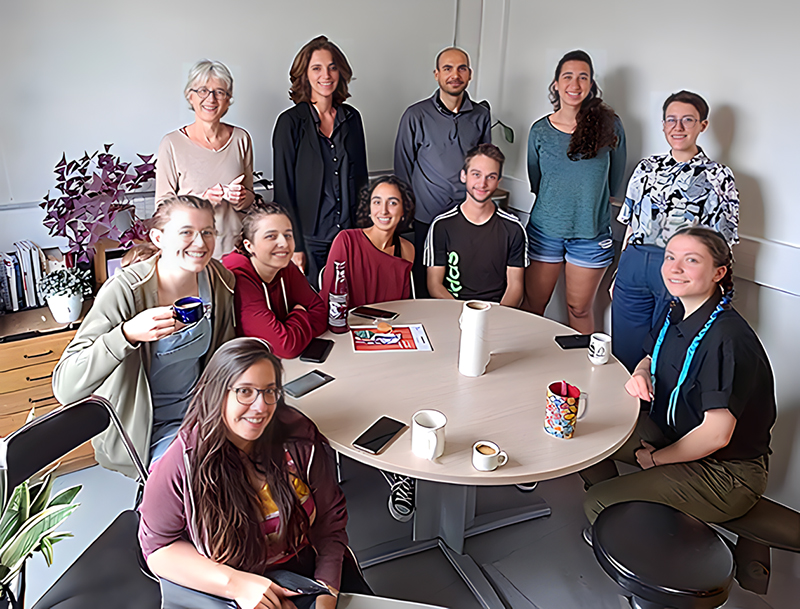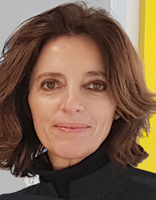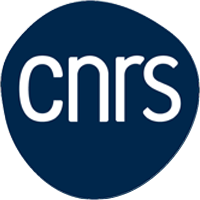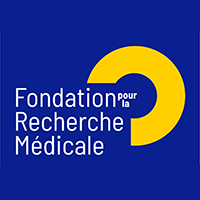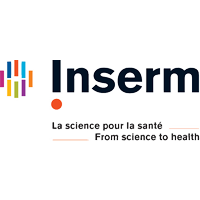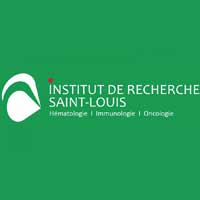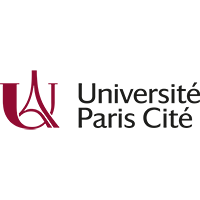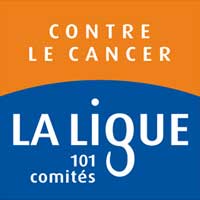Genomic research has reached a milestone with two decades of high-throughput sequencing data, leading to the characterization of the primary sequence of genomes and the first descriptions of their three-dimensional organization in cellular space. Key discoveries are full that eukaryotic chromosomes are full of dispersed, repeated and potentially mobile DNA sequences, called transposable elements and are not randomly organized in nuclear space.
We investigate the functional role of three-dimensional (3D) chromatin architecture in genome integrity and how this 3D chromatin architecture and transposable elements together contribute to genome organization and expression in the budding yeast model Saccharomyces cerevisiae. Because the presence of transposable elements in genomes and 3D chromosome organization are conserved features, exploring their connections will allow better understanding of their contribution in genome homeostasis.
Research Topics
Transposable Element integration site selection
The propagation and maintenance of transposable elements in genomes depend in part on the consequence of their insertion on gene expression. Some insertions will be maintained across generations because they provide an advantage to the organisms. Such insertions play an important role in genome evolution and speciation. Other insertions may be neutral or have short-term deleterious effects. In humans, many pathologies, such as genetic diseases or cancers, are correlated with an insertion that alters a gene function.
The location of transposable elements in specific regions of the genome can be the result of an active process that targets their integration into specific regions, where they will have minimal negative effect on the physiology of the organism. This is the case for the LTR-retrotransposon Ty1 of S. cerevisiae, which integrates primarily at two positions in the first 3 stable nucleosomes upstream of genes transcribed by RNA polymerase III (Pol III). This targeting protects the yeast genome because Pol III-transcribed genes are located in regions of the genomes devoid of essential genes.
Our goal is to understand the role of Pol III and chromatin structure in Ty1 integration site selection. We use a combination of genetic and genomic tools.
Chromosome organization in time and space and DSB repair
Genomes are constantly subjected to endogenous or exogenous threats. DNA double strand breaks are the most deleterious damage. Left unrepaired, the cell dies; repaired incorrectly, the cell might develop into cancer. Cells have therefore evolved sophisticated conserved mechanisms to ensure genome integrity. Among these mechanisms, the mobility of chromosomes, both at the site of damage and in undamaged chromosomal domains, is a conserved feature of threatens genomes.
Chromosome organization is functionally important for faithful repair to occur. At large scale, two types of chromosome spatial organizations are found during the interphase in eukaryotes: chromosome territories and the Rabl-like chromosome organization. The Rabl configuration, which has emerged multiple times during evolution, is characterized by centromeres clustering in the nucleus near the microtubule organization center or yeast Spindle Pole Body and telomeres anchoring to the nuclear envelope.
We address how gene activity and DNA damage can lead to complex spatial organization at the scale of the chromosomes and what controls chromosome mobility and repair. We have developed tools to generate double strand breaks at desired positions in the genome. By combining yeast genetics and genomics, cell biology in living cells and live-video microscopy and image analyses tools, we study chromosome mobility and architecture after DNA damage. We are interested in the interdisciplinary aspects of our research and regularly collaborate with physicists to refine chromosome models based on polymer physics and super resolution imaging.
Interplay between transposable elements, genome (in)stability and 3D genome organization
Both transposable element reactivation and genetic instability are frequently observed in cancer or aging. This genetic instability has in part been linked to insertion of new copies of retrotransposons or to recombination between existing copies of the same transposable element family in the genome. The transcription per se can be a source of instability. Our goal is to unravel the contribution of the expression of the LTR-retrotransposon Ty1 of S. cerevisiae to genomic instability and investigate the impact of 3D organization in Ty1-induced genomic rearrangements.
Transposable Element integration site selection
We have shown that Ty1 integration preferences for Pol III-transcribed genes is mediated by an interaction between the Ty1 integrase (IN1) and the AC40 subunit of Pol III (Bridier-Nahmias Science 2015). We have identified a stretch of residues in the C-terminus of IN1 (called TD1 for targeted domain of Ty1), which is necessary and sufficient for association with AC40, IN1 recruitment to Pol III-transcribed genes and Pol III-mediated integration (Asif-Laidin EMBO 2020). In collaboration, we have described the biochemical and structural characteristics of IN1 (Nguyen PH JBC 2021) and provided Cryo-EM structures of Pol III in complex with IN1, which confirmed that the TD1-AC40 interaction is sufficient for IN1 binding to Pol III and targeted integration (Nguyen PH Nature comm 2023). This structural study reveals that the interaction with IN1 associates with conformational changes in Pol III, that may favor its retention on chromatin, thereby improving the chance of Ty1 integration (Nguyen PH Nature comm 2023).
We are now exploring the role of chromatin in Ty1 integration profile and the molecular bases of Ty1 integration into subtelomeres, observed when the TD1-AC40 interaction is abolished (Bridier-Nahmias Science 2015, Asif-Laidin EMBO 2021).
Chromosome organization in time and space and DSB repair
We found that Rabl chromosome organization is defined by the attachment of centromeres to the yeast microtubule organizing center and the subtelomeres tethering to the nuclear periphery, in a position that depends on chromosome arm length and nucleolar volume (Therizols et al., PNAS 2010). This organization results in a high chromatin density near the centromeres. We have also shown that genes occupy a defined territory of limited volume (Berger et al., Nat Meth 2008), which can relocate to specific and distinct areas of the nucleus when highly expressed (Brickner et al., Cell Dev 2012). We have also shown that the dynamic behavior of chromosomes involves actin a component of the cytoskeleton. Close collaboration with physicists has allowed us to show that many of the principles of chromosome organization are recapitulated by polymer physics (Wong et al., Curr. Biol 2012; Arbona et al., Genome Biology, 2017).
We have shown that chromosome organization is critical for the efficiency of double-strand break repair (Therizols et al., JCB, 2006, Agmon et al., Nature Cell Biology 2013). We established that DNA mobility involves H2A phosphorylation and that chromosome organization is important in regulating chromatin mobility. (Herbert et al., EMBO J 2017; Garcia Fernandez et al., JCS 2021; Garcia Fernandez, eLife 2022).
We are now exploring the role of structural maintenance complex at pericentromeres in chromatin mobility and DSB repair.
Molecular bases of TE integration site selection (ISS)
► A small targeting domain in Ty1 integrase is sufficient to direct retrotransposon integration upstream of tRNA genes. Asif-Laidin A, Conesa C, Bonnet A, Grison C, Adhya I, Menouni R, Fayol H, Palmic N, Acker J, Lesage P.EMBO J. 2020 Sep 1;39(17):e104337. doi: 10.15252/embj.2019104337. Epub 2020 Jul 17.PMID: 32677087
► Barkova, A., A. Asif-Laidin, and P. Lesage, Genome-Wide Mapping of Yeast Retrotransposon Integration Target Sites. Methods Enzymol, (2018). 612: p. 197-223.
► Sultana, T., A. Zamborlini, G. Cristofari, and P. Lesage, Integration site selection by retroviruses and transposable elements in eukaryotes. Nat Rev Genet, (2017). 18(5): p. 292-308.
► Curcio, M.J., S. Lutz, and P. Lesage, The Ty1 LTR-retrotransposon of budding yeast, Saccharomyces cerevisiae. Microbiol Spectr, (2015). 3(2): p. 1-35.
► Bridier-Nahmias, A., A. Tchalikian-Cosson, J.A. Baller, R. Menouni, H. Fayol, A. Flores, A. Saib, M. Werner, D.F. Voytas, and P. Lesage, Retrotransposons. An RNA polymerase III subunit determines sites of retrotransposon integration. Science, (2015). 348(6234): p. 585-8.
► Bridier-Nahmias, A. and P. Lesage, Two large-scale analyses of Ty1 LTR-retrotransposon de novo insertion events indicate that Ty1 targets nucleosomal DNA near the H2A/H2B interface. Mob DNA, (2012). 3(1): p. 22.
► Servant, G., C. Pennetier, and P. Lesage, Remodeling yeast gene transcription by activating the Ty1 long terminal repeat retrotransposon under severe adenine deficiency. Mol Cell Biol, (2008). 28(17): p. 5543-54.
► Lesage, P. and A.L. Todeschini, Happy together: the life and times of Ty retrotransposons and their hosts. Cytogenet Genome Res, (2005). 110(1-4): p. 70-90.
► Structural basis of Ty1 integrase tethering to RNA polymerase III for targeted retrotransposon integration. Phong Quoc Nguyen, Sonia Huecas, Amna Asif-Laidin, Adrián Plaza-Pegueroles, Beatrice Capuzzi, Noé Palmic, Joël Acker, Juan Reguera, Pascale LESAGE*, Carlos Fernández-Tornero* (2022). bioRxiv 2022.03.07.483246; doi: https://doi.org/10.1101/2022.03.07.483246
► Bonnet A‡, Casier K‡, Carré C, Teysset L, LESAGE P* (2022). Transposable Elements: Parasite that Shape genome evolution, in Les séquences répétées, Richard G-F (guy-franck.richard@pasteur.fr) (dir.). 2023. ISTE Editions. (In press). Book Chapter
► A proteomic screen of Ty1 integrase partners identifies the protein kinase CK2 as a regulator of Ty1 retrotransposition. Barkova A, Indranil Adhya I‡, Conesa C‡, Asif-Laidin A, Bonnet A, Rabut E, Chagneau C, LESAGE P*, Acker J* (2022). Mobile DNA 2022. Nov 18;13(1):26. doi: 10.1186/s13100-022-00284-0.
► Bonnet A, LESAGE P. (2021). Light and shadow on the mechanisms of integration site selection in yeast Ty retrotransposon families. Curr Genet. 2021 Jun;67(3):347-357. doi: 10.1007/s00294-021-01154-7. Review
► Bonnet A*, LESAGE P (2022) [Restriction of transposable elements and genome evolution: A fine balance to set up]. Med Sci (Paris). 2022 Jan;38(1):18-20. doi: 10.1051/medsci/2021231. Epub 2022 Jan 21.PMID: 35060878 French. Book Chapter
► Bonnet A*, Chaput C, Palmic N, Palancade B‡, LESAGE P‡ (2021). A nuclear pore sub-complex restricts the propagation of Ty retrotransposons by limiting their transcription. PLoS Genet. 2021 Nov 1;17(11):e1009889. doi: 10.1371/journal.pgen.1009889.
Determinants of chromosome organization in budding yeast & Functional role of chromosome dynamic organization in DNA repair and stress
► Fabiola Garcia Fernandez†, Etienne Almayrac†, Ànnia Carré Simon, Renaud Batrin, Yasmine Khalil, Michel Boissac and Emmanuelle Fabre*. (2022). Global chromatin mobility induced by a DSB is dictated by chromosomal conformation and defines the outcome of Homologous Recombination. eLife. https://doi.org/10.7554/eLife.78015
► Fabiola Garcia Fernandez, Brenda Lemos, Yasmine Khalil, Renaud Batrin, James E. Haber and Fabre, E*. (2021) Modified chromosome structure caused by phosphomimetic H2A modulates the DNA damage response by increasing chromatin mobility in yeast, Journal of Cell Science, 134(6). PMID : 33622771.
► Bruhn, C., Ajazi, A., Ferrari, E., Lan, M.C., Batrin, R., Choudhary, R., Walvekar, A., Laxman, S., Longhese, M. P., Fabre, E., Bustamente , M., and Foiani., M. (2020). The Rad53CHK1/CHK2-Spt21NPAT and Tel1ATM axes couple glucose 1 tolerance to histone dosage and subtelomeric silencing. Nature Comm. 11(1): p 4154-4168. PMID: 32814778.
► Zimmer, C. and E. Fabre, Chromatin mobility upon DNA damage: state of the art and remaining questions. Curr Genet, (2019). 65(1): p. 1-9.
► Meriem, Z.B., Y. Khalil, P. Hersen*, and E. Fabre*, Hyperosmotic Stress Response Memory is Modulated by Gene Positioning in Yeast. Cells, (2019). 8(6).
► Fabre, E. and C. Zimmer, From dynamic chromatin architecture to DNA damage repair and back. Nucleus, (2018). 9(1): p. 161-170.
► Spichal, M. and E. Fabre, The emerging role of the cytoskeleton in chromosome dynamics. Frontiers in Genetics, (2017). in press: p. 681-92.
► Herbert, S., A. Brion, J.M. Arbona, M. Lelek, A. Veillet, B. Lelandais, J. Parmar, F.G. Fernandez, E. Almayrac, Y. Khalil, E. Birgy, E. Fabre*, and C. Zimmer*, Chromatin stiffening underlies enhanced locus mobility after DNA damage in budding yeast. EMBO J, (2017). 36(17): p. 2595-2608.
► Arbona, J.M., S. Herbert, E. Fabre, and C. Zimmer, Inferring the physical properties of yeast chromatin through Bayesian analysis of whole nucleus simulations. Genome Biol, (2017). 18(1): p. 81.
► Almayrac, E. and E. Fabre, Yeast nucleus: a model for chromosome folding principles. Nuclear Architecture and Dynamics hosted by Christophe Lavelle & Jean-Marc Victor in Translational Epigenetics series. Elsevier. (2017). Book chapter.
► Spichal, M., A. Brion, S. Herbert, A. Cournac, M. Marbouty, C. Zimmer, R. Koszul*, and E. Fabre*, Evidence for a dual role of actin in regulating chromosome organization and dynamics in yeast. J Cell Sci, (2016). 129(4): p. 681-92.
► Spichal, M. and E. Fabre, Subnuclear architecture of telomeres and subtelomeres in yeast. Springer-Verlag GmbH Berlin Heidelberg, (2014). Book chapter( XIV, 271 p. ): p. 13-39.
► Agmon, N., B. Liefshitz, C. Zimmer*, E. Fabre*, and M. Kupiec*, Effect of nuclear architecture on the efficiency of double-strand break repair. Nat Cell Biol, (2013). 15(6): p. 694-9.
► Wong, H., H. Marie-Nelly, S. Herbert, P. Carrivain, H. Blanc, R. Koszul, E. Fabre, and C. Zimmer, A predictive computational model of the dynamic 3D interphase yeast nucleus. Curr Biol, (2012). 22(20): p. 1881-90.
► Brickner, D.G., S. Ahmed, L. Meldi, A. Thompson, W. Light, M. Young, T.L. Hickman, F. Chu, E. Fabre, and J.H. Brickner, Transcription factor binding to a DNA zip code controls interchromosomal clustering at the nuclear periphery. Dev Cell, (2012). 22(6): p. 1234-46.
► Zimmer, C. and E. Fabre, Principles of chromosomal organization: lessons from yeast. J Cell Biol, (2011). 192(5): p. 723-33.
► Therizols, P., T. Duong, B. Dujon, C. Zimmer, and E. Fabre, Chromosome arm length and nuclear constraints determine the dynamic relationship of yeast subtelomeres. Proc Natl Acad Sci U S A, (2010). 107(5): p. 2025-30.
► Garcia-Fernandez, F and Fabre E* (2022). Chromatin Dynamics in response to DNA double-strand breaks. Genes 13(2):215. https://doi.org/ 10.3390/genes13020215
► Carré-Simon, À and Fabre, E* (2021). 3D Genome Organization: Causes and Consequences for DNA Damage and Repair. Genes 13(1):7. https://doi.org/ 10.3390/genes13010007
Determinants of chromosome organization in mES cells
► A. Canat, A. Veillet, R. Illingworth, E. Fabre, P. Therizols. (2021), DAXX safeguards pericentromeric heterochromatin formation in embryonic stem cells. bioRXiv, 2021.04.28.441827.
► Canat, A., A. Veillet, A. Bonnet, and P. Therizols, Genome anchoring to nuclear landmarks drives functional compartmentalization of the nuclear space. Brief Funct Genomics, (2020). 19(2): p. 101-110.
► Benabdallah, N.S., I. Williamson, R.S. Illingworth, L. Kane, S. Boyle, D. Sengupta, G.R. Grimes, P. Therizols, and W.A. Bickmore, Decreased Enhancer-Promoter Proximity Accompanying Enhancer Activation. Mol Cell, (2019). 76(3): p. 473-484 e7.
► Florescu, A.M., P. Therizols, and A. Rosa, Large Scale Chromosome Folding Is Stable against Local Changes in Chromatin Structure. PLoS Comput Biol, (2016). 12(6): p. e1004987.
► Therizols, P., R.S. Illingworth, C. Courilleau, S. Boyle, A.J. Wood, and W.A. Bickmore, Chromatin decondensation is sufficient to alter nuclear organization in embryonic stem cells. Science, (2014). 346(6214): p. 1238-42.
Pierre THERIZOLS
CRCN Epigénétique et Destin Cellulaire
Amandine BONNET
Ingineer CEA
Noé PALMIC
Technician Tours
Florian SUTZ
Engineer
Amna LAIDIN
Postdoc Les Cordeliers
Ana RIVAROLA
Professor in Paraguay
Fabiola GARCIA-FERNANDEZ
Postdoc, Institut Curie
Alexa TAMBON
PhD Student
Alessia ZAMBORLINI
Professor – Paris Sud
Joëlle TOBALY-TAPIERO
Retirement
Yasmine KHALIL
Engineer
Adeline VEILLET
Research Engineer
Étienne ALMAYRAC
Teaching
Anastasia BARKOVA
Research Engineer
Carole CHAPUT
Master Student, Université de Paris
Éléonore BIRGY
Engineer, Institut Imagine
Alice BRION
Engineer, MNHN
Zacchari BEN MERIEM
Postdoc
Antoine BRIDIER-NAHMIAS
Assistant Professor, Université de Paris
Audrey COIFFIC
PhD Sales Manager, PathoQuest
Arthur CORMIER
Engineer
Camille GRISON
Software engineer, Capgemini DCX
Sébastien HERBERT
Research Engineer, Basel University
Imen LASSADI
Postdoc
Charlotte MARTINAT
IR, Pôle de Médecine Diagnostique et Théranostique de l’Ensemble Hospitalier, Institut Curie
Rachid MENOUNI
Teacher
Julie RENARD
Engineer
Maya SPICHAL
Postdoc
Baptiste ODIC
Engineer
